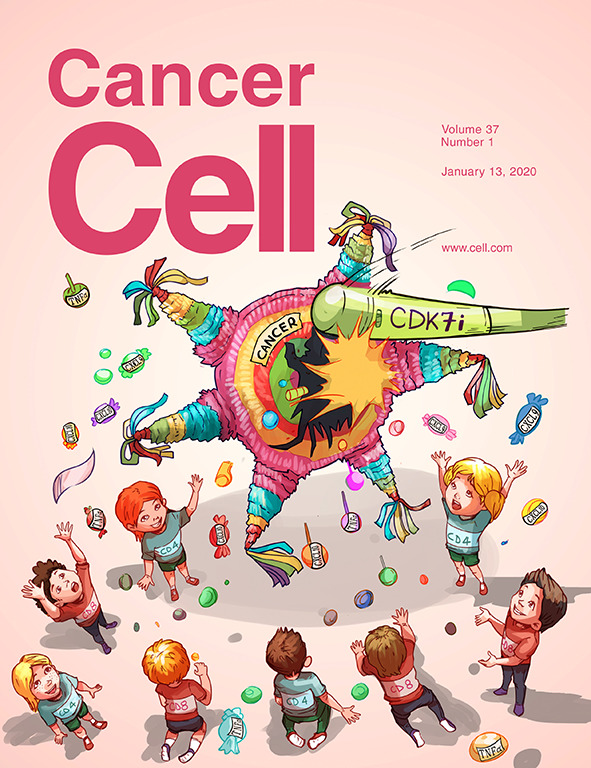放疗促进铜体增生,并与铜体增生诱导剂协同克服肿瘤放射耐药
IF 44.5
1区 医学
Q1 CELL BIOLOGY
引用次数: 0
摘要
铜增生是最近发现的一种依赖铜的细胞死亡形式。在这里,我们揭示了放疗(RT)诱导癌细胞铜下沉,独立于细胞凋亡和铁下沉,并消耗患者肿瘤中脂酰化蛋白和铁硫(Fe-S)簇蛋白-这两种铜下沉的标志。在机制上,RT通过上调铜转运蛋白1 (copper transporter 1, CTR1)和消耗线粒体谷胱甘肽(一种铜螯合剂)来提高线粒体铜水平,从而引发铜还原。综合分析放射耐药食管癌细胞的RNA测序(RNA-seq)和放疗无反应食管癌患者的单细胞RNA测序(RNA-seq),发现放射耐药与BTB和CNC同源1 (BACH1)下调有关。这种下调抑制了铜螯合金属硫蛋白(MT) 1E/X的表达,从而减轻了铜增生并促进了辐射抗性。铜离子载体治疗通过增强铜增殖使放射耐药的癌细胞和细胞系及患者来源的异种移植物对放射治疗增敏。我们的研究结果揭示了放疗与铜凸之间的联系,并为通过靶向铜凸来克服肿瘤放射耐药的治疗策略提供了信息。本文章由计算机程序翻译,如有差异,请以英文原文为准。

Radiotherapy promotes cuproptosis and synergizes with cuproptosis inducers to overcome tumor radioresistance
Cuproptosis is a recently identified form of copper-dependent cell death. Here, we reveal that radiotherapy (RT) induces cuproptosis in cancer cells, independent of apoptosis and ferroptosis, and depletes lipoylated proteins and iron-sulfur (Fe-S) cluster proteins—both hallmarks of cuproptosis—in patient tumors. Mechanistically, RT elevates mitochondrial copper levels by upregulating copper transporter 1 (CTR1) and depleting mitochondrial glutathione, a copper chelator, thereby triggering cuproptosis. Integrated analyses of RNA sequencing (RNA-seq) from radioresistant esophageal cancer cells and single-cell RNA-seq from esophageal tumors of patients unresponsive to RT link radioresistance to the downregulation of BTB and CNC homology 1 (BACH1). This downregulation de-represses the expression of copper-sequestering metallothionein (MT) 1E/X, thereby mitigating cuproptosis and contributing to radioresistance. Copper ionophore treatment sensitizes radioresistant cancer cells and cell line- and patient-derived xenografts to RT by potentiating cuproptosis. Our findings unveil a link between RT and cuproptosis and inform a therapeutic strategy to overcome tumor radioresistance by targeting cuproptosis.
求助全文
通过发布文献求助,成功后即可免费获取论文全文。
去求助
来源期刊

Cancer Cell
医学-肿瘤学
CiteScore
55.20
自引率
1.20%
发文量
179
审稿时长
4-8 weeks
期刊介绍:
Cancer Cell is a journal that focuses on promoting major advances in cancer research and oncology. The primary criteria for considering manuscripts are as follows:
Major advances: Manuscripts should provide significant advancements in answering important questions related to naturally occurring cancers.
Translational research: The journal welcomes translational research, which involves the application of basic scientific findings to human health and clinical practice.
Clinical investigations: Cancer Cell is interested in publishing clinical investigations that contribute to establishing new paradigms in the treatment, diagnosis, or prevention of cancers.
Insights into cancer biology: The journal values clinical investigations that provide important insights into cancer biology beyond what has been revealed by preclinical studies.
Mechanism-based proof-of-principle studies: Cancer Cell encourages the publication of mechanism-based proof-of-principle clinical studies, which demonstrate the feasibility of a specific therapeutic approach or diagnostic test.
 求助内容:
求助内容: 应助结果提醒方式:
应助结果提醒方式:


